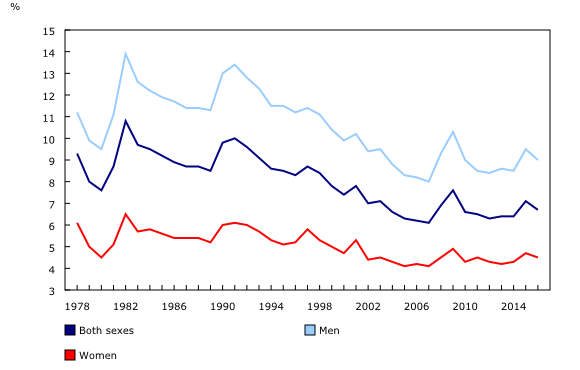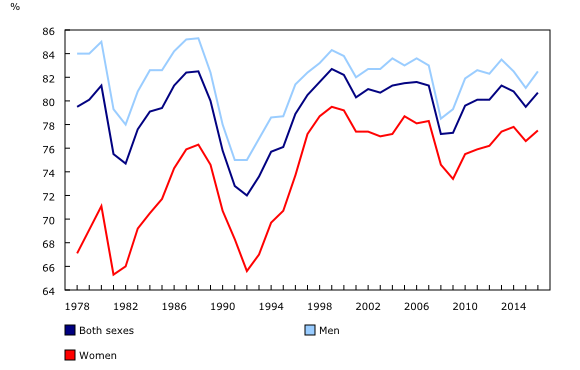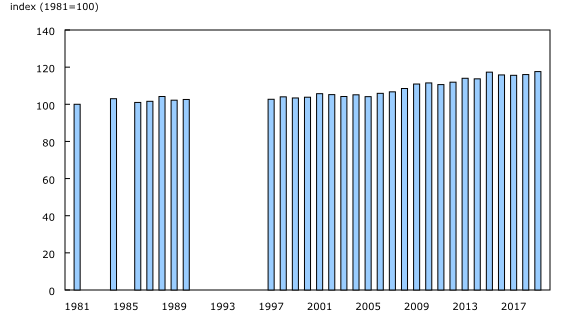Study: Job displacement and job types over the last four decades
Archived Content
Information identified as archived is provided for reference, research or recordkeeping purposes. It is not subject to the Government of Canada Web Standards and has not been altered or updated since it was archived. Please "contact us" to request a format other than those available.
Released: 2020-06-23
The Canadian labour market has experienced important changes over the last four decades, the most recent one being triggered by the COVID-19 pandemic. Today, Statistics Canada releases two studies that shed light on several of these labour market developments.
The first research article, titled "Permanent Layoff Rates in Canada, 1978 to 2016," analyzes the evolution of permanent layoff rates in Canada from 1978 to 2016, the last year for which data on permanent layoffs are currently available. A longer version, titled "Turbulence or Steady Course? Permanent Layoffs in Canada, 1978 to 2016," assesses the financial consequences these job losses have had for Canadian displaced workers over the last four decades. This longer version has been produced in collaboration with the Institute for Research on Public Policy (IRPP) and is being released today by IRPP.
These studies find little evidence that the extent of job displacement or its financial consequences for laid-off workers have worsened from 1978 to 2016. However, they show that long-tenure displaced workers—who have been with their employer for six years or more—experienced substantial earnings losses even five years after job loss. These studies also find that most job losses usually occur in non-mass layoffs.
Of course, concerns about job displacement have taken on a new importance in the context of the COVID-19 pandemic. At this time, it is still too soon to predict the severity and duration of the resulting economic downturn, and hence the extent to which the layoffs will be temporary or permanent.
The second research article, titled "The Changing Job Landscape, 1981 to 2019," shows how several job characteristics—such as real hourly wages, pension plan coverage, unionization, and the permanent or temporary nature of a job—have evolved since the early 1980s.
The study finds that most job characteristics have evolved differently for men and women over the last four decades. From 1981 to the late 2010s, pension plan coverage, unionization rates and the relative importance of permanent full-time jobs in total paid employment have fallen for men but not for women. Changes in job characteristics have not been uniform for young and older workers either.
Other job characteristics obviously matter in the wake of the COVID-19 pandemic. COVID-19 might prompt firms to accelerate the automation of certain tasks, to increase gig employment and telework and to implement changes in work arrangements (e.g., shiftwork, configuration of office spaces) that facilitate physical distancing. Due to data limitations, the study did not track the evolution of work arrangements and rates of telework since the early 1980s.
The likelihood of Canadian workers losing their job did not increase from 1978 to 2016
Since the late 1970s, computer-based technologies have reduced the demand for labour in some segments of the economy, while creating new occupations such as web security analysts, software developers and application developers. New forms of employment—for example, temporary jobs and gig employment—have emerged. Manufacturing employment has declined, while international trade has increased.
Despite these numerous changes in the economic environment, the likelihood of Canadian workers losing their job has not increased from 1978 to 2016. From 2010 to 2016, permanent layoff rates among employees aged 25 to 64 averaged 6.6%, about one and a half percentage points lower than the 8.3% average from 1978 to 1980.
Some regional differences are worth noting. Following declines in oil prices, permanent layoff rates rose sharply in the oil-producing provinces of Alberta, Saskatchewan, and Newfoundland and Labrador in 2015 and 2016. For example, permanent layoff rates in Alberta increased from 7.9% in 2014 to 12.2% in 2015. However, permanent layoff rates in other provinces were fairly stable from 2010 to 2016.
The proportion of displaced women who find a new job shortly after job loss increased from 1978 to 2016
While permanent layoff rates did not trend upward, short-term re-employment rates—the percentage of permanently laid-off workers who found new paid jobs in the year following job loss—followed different trajectories for men and women.
As women increased their labour market participation, the percentage of permanently laid-off women who had paid employment in the year following job loss grew over time, reaching 78% in 2016, up from 67% in 1978. In contrast, the percentage of displaced men who were re-employed in the year following job loss hovered around 80% and displayed cyclical fluctuations but no clear trend.
The short-term impact of job loss on earnings did not worsen from 1978 to 2016
Regardless of the years considered, the typical displaced worker ended up in a worse financial position in the year following job loss than in the year before job loss. For example, men and women who were permanently laid off in 2015 had a median percentage drop in earnings of 25% from 2014 to 2016.
However, the magnitude of these short-term earnings declines did not worsen across decades. While the short-term earnings declines of men displayed no clear trend, the short-term earnings declines for women have become less pronounced over time.
Although, overall, job displacement has not become more frequent and post-displacement employment and earnings outcomes have not worsened from 1978 to 2016, long-tenure displaced workers—who have been with their employer for six years or more—experienced significant and persistent earnings losses.
For example, at least one-half of long tenure displaced men and women aged 25 to 54 saw their real earnings decline by at least 10% from the year before job loss to five years after job loss.
Most job losses occurred outside mass layoffs
While media reports often highlight mass layoffs that take place in particular cities or regions, relatively little attention is paid to job losses that do not come from mass layoffs, such as those in small firms. Yet most job losses that took place in the commercial sector since the miD-1990s—the first period for which data on mass layoffs are available—occurred outside mass layoffs.
Over the 1995-to-2015 period, between 53% and 87% of the permanent layoffs in the commercial sector occurred in non-mass layoffs. This finding should be kept in mind as new reports of job losses emerge during and after the COVID-19 pandemic.
Wages grew moderately since the early 1980s but pension plan coverage fell
The last four decades have also seen significant changes in the pay rates of Canadian workers and in the types of jobs they hold.
From 1981 to 2019, median real hourly wages in full-time jobs increased by 18%, with most of the growth occurring after 2005.
As wages grew moderately, pension plan coverage fell. From 1981 to 2017—the most recent year for which data on pension plan coverage are available—the percentage of employees with a registered pension plan (RPP) fell by 8 percentage points, dropping from 45% in 1981 to 37% in 2017.
Job characteristics evolved differently for different groups of workers
As women increased their presence in highly paid jobs and their tenure with employers, their median real hourly wages in full-time jobs grew 30% from 1981 to 2019, more than three times the 9% growth observed for men. Nevertheless, women still had lower median wages than men in 2019.
Changes in job types have also not been uniform for men and women.
For example, the percentage of men with an RPP dropped from 51% in 1981 to 35% in 2017. In contrast, women's RPP coverage increased from 35% to 39% over the same period.
Pay rates and job types also evolved differently for young employees and older employees.
For example, the median real hourly wages of men aged 25 to 34 employed full time were almost the same in 1981 and 2019, but those of men aged 35 to 54 grew by 13% during that period.
Likewise, the median real hourly wages of women aged 35 to 54 increased by 38% from 1981 to 2019, almost twice the 20% increase observed among young women.
As a result of employment losses since February 2020, full-time permanent jobs and unionized jobs have recently gained prominence
It is too early at this point to know whether the COVID-19 pandemic will alter some of these long-term trends. However, some recent changes are worth noting.
Because employment losses since February 2020 have been more pronounced in temporary jobs and in non-unionized jobs, the percentage of employees in full-time permanent jobs and in unionized jobs grew from May 2019 to May 2020.
In May 2020, 81% of employees aged 17 to 64 held full-time permanent jobs, up from 76% in May 2019. Likewise, the proportion of employees in unionized jobs increased from 29% to 31% during that period.
Median real hourly wages in full-time jobs increased by roughly 11% from May 2019 to May 2020 and average real hourly wages grew by about 9%. About half of the growth in average wages can be accounted for by recent changes in employment away from temporary jobs, non-unionized jobs, and industries and occupations that pay relatively low wages.
Note to readers
The study titled "Turbulence or Steady Course? Permanent Layoffs in Canada, 1978 to 2016" and the Economic Insights article titled "Permanent Layoff Rates in Canada, 1978 to 2016" use data from Statistics Canada's Longitudinal Worker File.
Both studies use permanent layoffs to measure job losses. A permanent layoff occurs when the laid-off employee does not return to her former employer in the year of the layoff or the following year. Otherwise, a layoff is deemed temporary.
Permanent layoff rates equal the number of jobs ending with a permanent layoff, as a percentage of average paid employment in a given year.
Mass layoffs are defined as permanent layoffs that take place in enterprises (1) that had at least 50 employees in year t − 1 the year before job loss; (2) that had positive payroll (that is, that paid workers for at least part of the year) in both year t − 1 and year t; (3) whose total permanent layoffs in year t represented 10% or more of employment in year t − 1; and (4) whose total payroll fell by at least 10% from year t – 1 to year t + 1. All other permanent layoffs are deemed non-mass layoffs.
The commercial sector comprises all industries except public administration, educational services, health care and social assistance.
Products
The research articles titled "Permanent Layoff Rates in Canada, 1978 to 2016," and "The Changing Job Landscape, 1981 to 2019," part of the Economic Insights Series (11-626-X), are now available.
Contact information
For more information, contact us (toll-free 1-800-263-1136; 514-283-8300; STATCAN.infostats-infostats.STATCAN@canada.ca).
To enquire about the concepts, methods or data quality of this release, contact René Morissette, (rene.morissette@canada.ca), Social Analysis and Modelling Division.
- Date modified:




